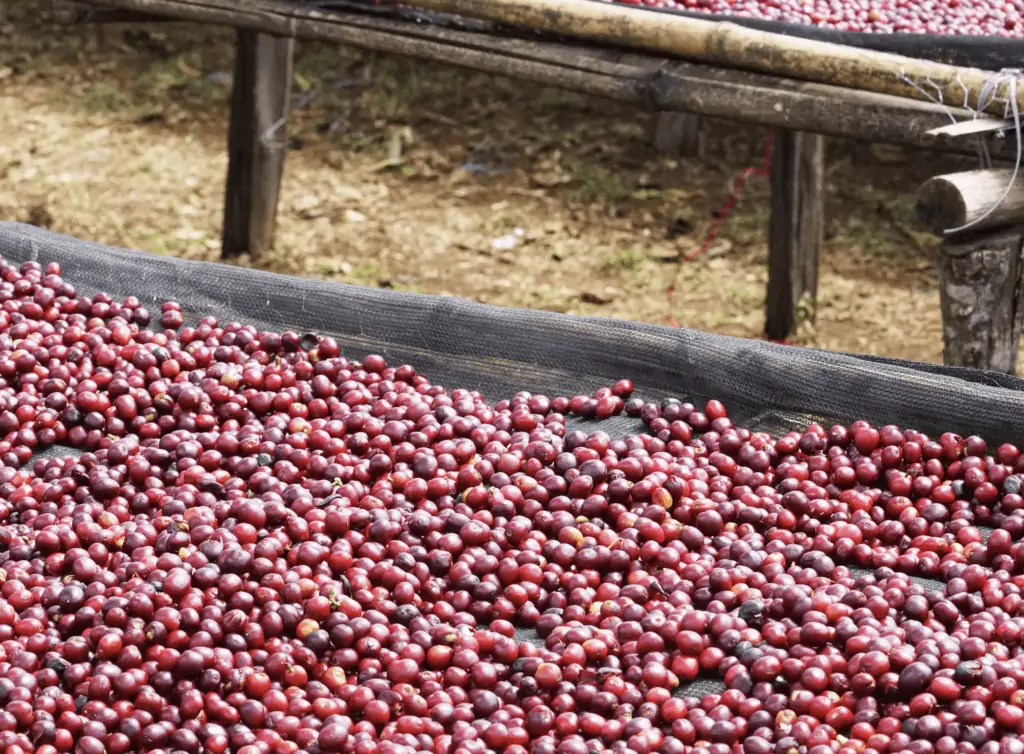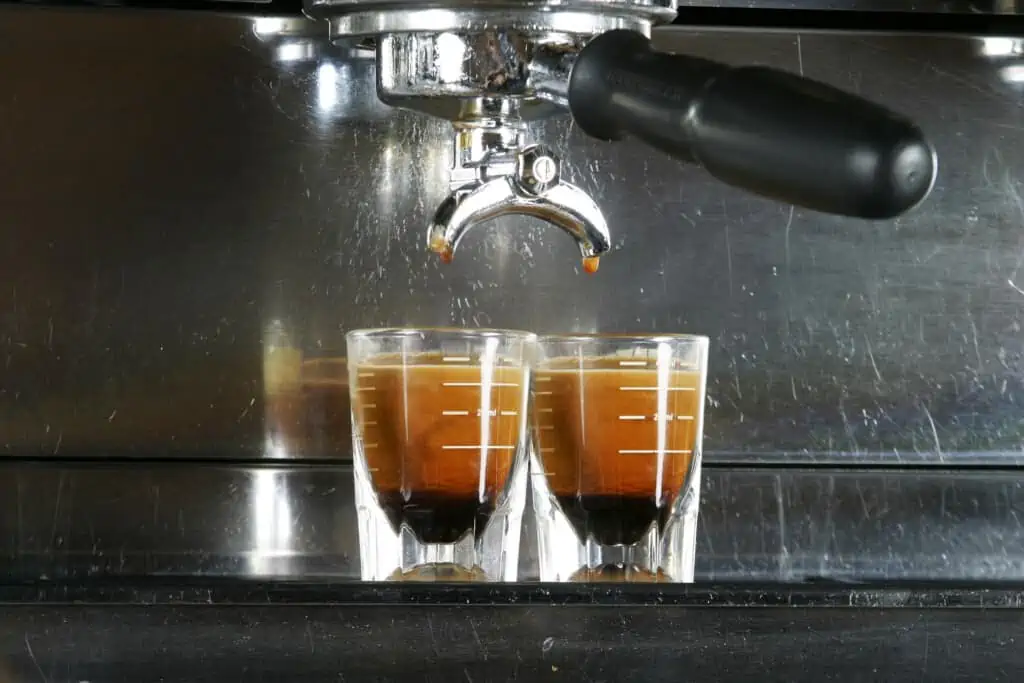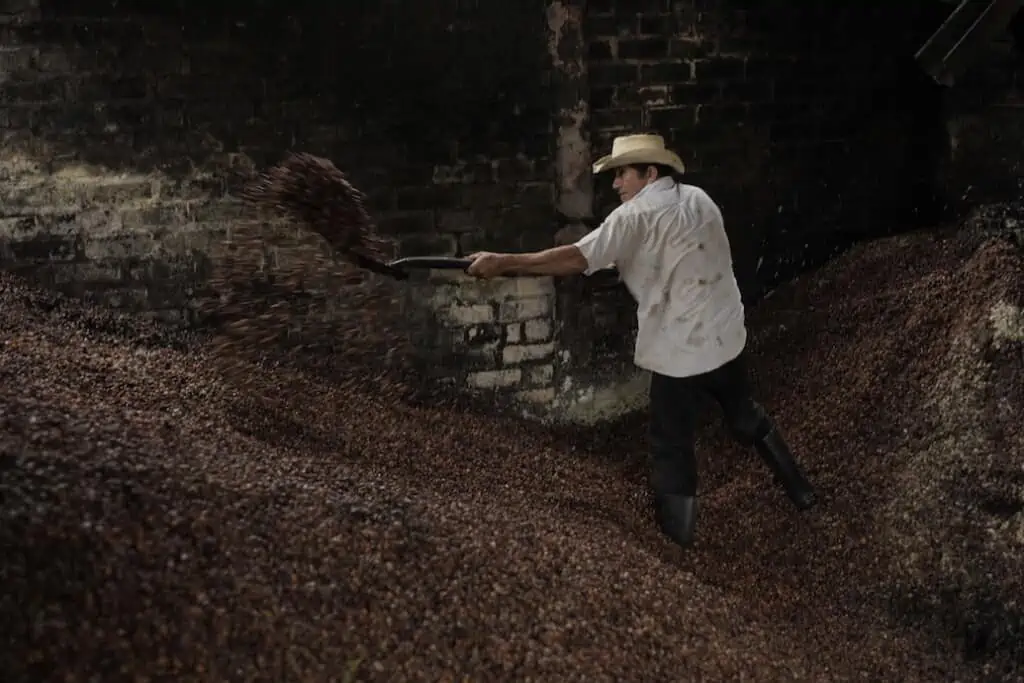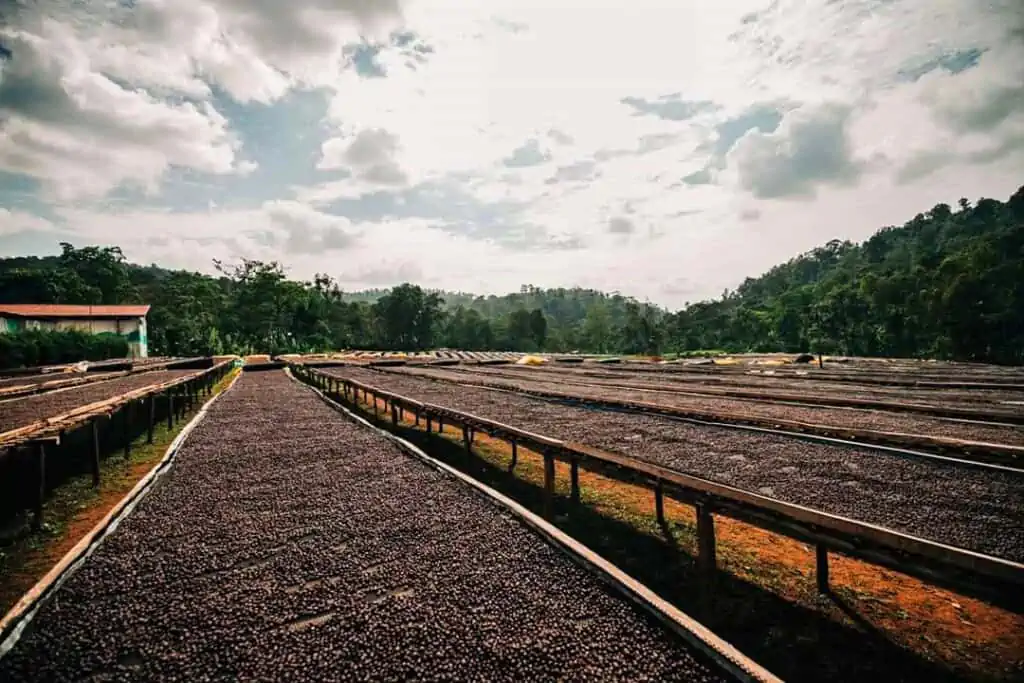
Coffee cherries drying in the whole fruit. Courtesy of Felala Coffee.
The Coffee Review lab has smelled like a candy store for the last few weeks — a Willy Wonka factory for grownups. Of the hundreds of coffees we cup every year, a growing percentage of them are natural-processed. In the wine world, the word “natural” doesn’t mean anything in particular, is more of a marketing term designed to imply minimal intervention in the winemaking process. In coffee, “natural” processing means something very specific: that the beans or seeds are dried inside the entire coffee fruit. This approach differs from the “washed” (or wet) method, in which the beans are stripped of their fruit before they are dried. Both approaches have profound impact on the sensory character of the green coffee. As in winemaking, natural processing of coffee is a minimal-intervention process in its most basic form.
But now, “basic” natural processing — which typically involves drying whole coffee cherries on concrete patios or screen tables in the sun, raking and turning them often to avoid mold and encourage even drying — is being pushed further by farmers and mill operators looking to distinguish and intensify their coffees. Their main strategy is adding a fermentation step before the coffee fruit is laid out to dry. The fermentation is being further elaborated by adding wine yeasts, conducting the fermentation in sealed tanks (the anaerobic method), freezing coffee fruit before drying it, and other novel processing experiments. Whatever you think of this trend toward experimentation, it’s clear that it’s not a passing fancy. The intense aromas now filling the Coffee Review lab may be the result of various processing wrinkles, but they share at least one common denominator — the coffee cherries all have been dried in the whole fruit.

Two shots of espresso being drawn from a professional espresso machine.
This month, we asked roasters to send us natural-processed single-origin coffees they’ve roasted for espresso format. We received a wide range of samples, from the classic to the wildly creative. Of the 10 coffees we review here, five are straight naturals, dried in the whole fruit without any additional steps in the process, while five are more experimental, with added steps such as anaerobic fermentation or fermentation with yeast added.
Focusing on single-origin coffees (as opposed to blends) makes this an interesting inquiry because it effectively eliminates the impact of blending. Classic espresso blends often combine low-toned, chocolaty coffees with high-toned, fruity coffees, for example, and there is generally a broad spectrum of creativity in the blend component choices and their ratios. Here, the roasters had to work with what the green coffee offered, in effect getting out of the way except, of course, for the crucial acts of selecting the coffees and developing their roast profiles. One thing is clear: Roasters who are working with naturals are not afraid of big fruit, which characterizes all of this month’s coffees.
Omni-Coffees Are Also In
And it’s probably not a coincidence that nine of the 10 coffees reviewed here are light- or medium-roasted. Just one, Simon Hsieh’s “Chasing Horizon” (95) is roasted to medium-dark, but darker roasts are Hsieh’s specialty and the focus of his company’s brand, so that’s not surprising. The other roasters are working clearly within the third-wave model of lighter roasting. In any case, big fruit and light roasting tend to provide different challenges for espresso, both in the straight shot and in milk drinks, and some interesting spins emerged in our discussions with roasters. Except for Hsieh’s Chasing Horizon and Hula Daddy’s Kona Natural Espresso, none of the coffees reviewed this month is presented on roasters’ websites as exclusively for espresso; rather, they are offered for unspecified brewing applications. So, whether you’re shopping for coffees for pourovers or home espressos, the roast profile you buy is the same, essentially making them “omni” coffees aimed at working well in either format.
A Note About Acidity
While Coffee Review’s evaluation format for coffees cupped for brewed or non-espresso applications includes explicit consideration of acidity, our espresso review form does not prompt us to take acidity into account. You’ll find acidity indirectly referenced in our global descriptions that describe structure, such as “sweetly tart,” “richly savory,” “gently herbaceous.” But the truth is that this month’s mostly lighter-roasted naturals express a clear acidity that’s unmuted by deeper roast levels, and it is here that one’s preferences may come into play. You know who you are: If you dig a bright acidity with juicy fruit front and center, you’ll find a lot to love here; if you go to espresso primarily for round, chocolaty shots, you may be disappointed. In other words, these are largely what we call caveat coffees, love or hate affairs, in this case because of their tendency toward the intensely bright fruit end of the flavor spectrum. Regardless of your sensory camp or your attachment to it, however, these 10 coffees represent extraordinary expressions of single-origin natural-processed coffees, ranging in score from 93 to 95.
Five Classic Naturals
We review five coffees that are processed by the basic natural method, again, simply dried in the whole fruit with daily care and attention during the process to ensure that the cherries dry evenly and cleanly.
Barth Anderson, of Barrington Coffee Roasting, whose “Supernatural” scored 95, says, “I typically gravitate to gently applied natural-process coffees favoring delicate and elusive characteristics — not so the case with the Supernatural from Durato Bombe. With this coffee, I am drawn to its straight-ahead application of the natural process. On our first pass on the cupping table at a very light roast, it reminded me of the surprise I experienced when I tasted my very first natural. It was a blueberry powerhouse. What sets it apart is the focus and refinement in its delivery. I hold its producers Asefa and Mulugeta Dukamo entirely responsible for such finesse.
It’s heft, depth and abundant chocolate make it a shoo-in for pushing the roast treatment into medium and showcasing it as a single-origin espresso. As expected, our shot trials proved to enhance what we liked most about it on the cupping table.” We also found this coffee to be as complex as it is intense, with watermelon candy notes at the top and savory leaning herb notes underneath. The chocolate is a throughline but not the coffee’s most prominent feature, rather it is an integrated part of the whole.
Roaster Jason Yang of Felala Coffee says he was drawn to “the intensity and complexity of the flavors” of his Ethiopia Alemaza Natural (95), “accompanied by the acidity and sweetness inherent in the coffee, which creates a harmonious experience.” He describes the challenge of roasting this high-density green coffee, including his decision “not to touch second crack in order to keep more of the fruitiness and to keep the balance of sweetness with the chocolate notes.” We picked up on the dark chocolate note, but found tart pomegranate, bittersweet blood orange zest, and rich sandalwood to be even more prominent.
Kakalove Café’s Honduras Natural San Vicente Belarmino Contreras Pacas (94), whose berry-driven, richly floral process we loved, attracted roaster Caesar Tu “because of the coffee’s well-known provenance, as San Vicente is a famous washing station that has won the Cup of Excellence many times.” He adds that he appreciates the San Vicente mill’s focus on small farmers and variety of processes. The San Vincente is especially elegant, displaying pungent florals in both the straight shot and in milk alongside a mulberry-like purple fruit note.
Simon Hsieh’s “Chasing Horizon” (95) is a blend of three Ethiopian naturals from the Guji and Yirgacheffe regions. Hsieh says that while these three coffees each have a different character, they all share “a clean cup without over-fermented taints.” He adds that, “One plays well in aroma and brightness, one plays a great winey/chocolaty role, while the last provides very attractive body and aftertaste. When they stand alone, they might lack certain strengths, but together they work with full power.” We found this single-origin blend to be as floral as it is chocolaty, with sweet-spicy hyacinth-like florals as its anchor.
Rounding out the classic naturals is Modern Times’ Ethiopia Guracho Natural (93), which is delicately berry-toned and richly sweet, with notes of blackberry coulis, cocoa nib, agave syrup, cedar and creamy macadamia nut. It’s especially pretty in cappuccino format, where berry and cocoa notes balance rich aromatic cedar.
Roastery manager Seancarlo Ohlin says of this coffee, “We have always been huge fans of natural Ethiopian coffees and have made it a focal point of our coffee program. We sourced this coffee from Atlas Coffee Importers and have been working with them for a number of years. This coffee was sourced as a blending component but immediately turned heads on the cupping table. We decided it was great as a single origin, and it tasted fantastic on bar. Our espresso roasts generally have an extended roast development, but we decided to run our normal development for this single-origin coffee, and we’re happy we did! It’s bursting with juicy fruit characteristics that delightfully linger on the palate. Shout out to our head roaster Courtney Heald for mastering this roast!”
Five Naturals on Steroids — The Experimental Spectrum
Now to the experimentally processed naturals, also dried in the whole fruit but with an extra twist. These innovations tend to be proprietary to producers (secret recipes, if you will), but each roaster shared a bit about the method and the reasons they were drawn to these coffees as espressos. Experimental processes of any kind are usually intended to intensify or highlight a particular aspect of the green coffee. In the case of naturals, it’s usually all about the fruit, and usually involves adding a fermentation step before the coffee fruit is dried.
Two of these coffees made the fermentation step anaerobic, meaning the fermentation was conducted in sealed tanks to eliminate oxygen and yeast fermentation while promoting bacterial or lactic acid fermentation. The anaerobic step seemed to promote depth and complexity in terms of savory florals and other umami impulses, nuancing the fruit and sweetness.
Fortifying fermentation with various yeasts is another new(ish) processing frontier and, again, producers and their roaster partners often prefer to hold their cards close as far as specific details go. But we know that common experiments include the addition of wine yeasts to the coffee fermentation. There is always yeast present during fermentation, but the idea is that controlling the specific strains can produce more favorable aroma and flavor outcomes.
We tend to avoid the term “exotic” because it’s often used in the context of cultural appropriation (i.e., categorically “other” in relation to our own experience, but perhaps typical in someone else’s). But it wouldn’t be inappropriate to use it to describe some of these experimental coffees as, frankly, universally non-coffee-like. For many producers working in the experimental realm, this is the goal: to broaden a coffee’s sensory range into the areas of tea, wine, even non-beverages like cheese or yogurt.
For many years, we’ve followed Hula Daddy Kona Coffee’s yeast fermentation experiments with coffee grown at its own Kona farm. It’s only just recently that roaster Laura Ross decided to start working with roast profiles aimed at espresso applications. This month’s Kona Natural Espresso (95) is richly chocolaty, sweetly nutty and subtly fruity. Wine yeasts added to a fermentation step seem to have intensified both aroma and flavor.

Rigoberto Herrera scooping dried coffee cherries at Colombia’s Granja La Esperanza Farm. Courtesy of PT’s Coffee Roasting Co.
PT’s Colombia Tres Dragones Natural (94) was processed by what producers Rigoberto and Rodrigo Herrera of Finca Potosi, known for their expertise in fermentation, call a “hybrid natural” method, meaning that the coffee was both fermented and dried in the whole fruit. Roaster Mike Mazulo says, “The Tres Dragones Natural, year after year, has continued to show the care and dedication taken at Granja La Esperanza with this lot, as they do with all their coffee, always working to refine their processes. It has been a hit every year, both as espresso and brewed. I love a natural espresso that is dynamic as a single shot, in milk, or over a scoop of ice cream — it’s vibrant, sweet, deep, rich, and complex, with ripe to macerated fruit-forward flavor and the body to complement. The attention to detail in natural processing can really highlight the effort of the farmers.” We experienced this coffee as winey and musky, richly chocolaty — satiating in its herbaceous, savory depth and fruity lift. It’s a good example of the delicate sweet ferment that can be achieved in coffee, slightly and intentionally evocative of alcohol.
We also review two anerobic natural-processed coffees, in which the whole cherries are fermented in an oxygen-free, hermetically sealed vessel before drying, giving them an intensity and depth that works well in espresso format. Paradise’s Colombia Quindio Anaerobic Natural (94) displays notes of tropical fruit (rambutan) and bittersweet citrus (kumquat) ensconced in deep chocolate notes. This is a coffee that we also recently reviewed as a brewed coffee at 94. When cupped rather than brewed as espresso, it displayed different dominant aroma and flavor notes (link to review). Roaster Miguel Meza says, “In a natural coffee for espresso, we look for fruit and intense distinctive flavors. This coffee seems to have cinnamon added to the fermentation, and we liked how that came through in a shot of espresso, along with the sweetness and roundness of the mouthfeel from the anaerobic natural processing. We actually did not roast this coffee with espresso in mind; it is a lighter roast intended for filter use that just happened to make an interesting espresso, as well.” While we didn’t detect the cinnamon note, we did hone in on sandalwood, a similarly spice-toned descriptor.

Coffee drying on raised beds at Faysel Abodsh’s Testi Washing Station in Sidama, Ethiopia. Courtesy of modcup coffee.
Travas Clifton, founder of modcup coffee, comments: “Whenever we are using natural coffees for espresso, we are looking to highlight a component central to our branding: [the fact that] Coffee is a Fruit. Before we talk about anything in coffee, we must understand that the bean is actually a seed, a seed of an incredible flavor-complex fruit.” In the case of modcup’s Fruit Bomb/Ethiopia Shantewene (93) the fruit is present and intense, with an engaging lean toward the savory and tart almost certainly promoted by an anaerobic ferment step.
Perhaps the most unusual processing method of all is represented here by GK Coffee’s Colombia Finca Jardines del Eden Ice Fermentation Natural (94), whose processing involved freezing the coffee cherries right after harvest for five days, slowing the drying and increasing the sweetness of the fruit. Roaster Gary Liao says that the innovative processing method resulted in a super-sweet coffee that inspired him to create an ice caffè latte with pudding for his café. He loves the profile for its winey presentation and dessert-like qualities.

A barista completes an attractive pour of frothed milk to a cappuccino.
Milk Is a Strange Bedfellow
These 10 natural-processed single-origin coffees, tested as espressos, are all clear representations of their respective green coffees and their processing methods, and each offers a strikingly divergent presentation in cappuccino format. With classic espresso blends, chocolate notes tend to dominate in milk formats, but these naturals expand our sense of how coffee can play with milk, from the decadently floral and almost over-the-top fruity to the more traditional chocolaty and nutty, with a middle ground of savory, herbaceous umami. Read through the reviews to get a sense of how these coffees build on the notion of how a cappuccino can taste when it’s a bit out of the box. Again, one’s preferences will reign supreme, as they should, but these coffees give us a chance to push our sensory boundaries in new and exciting ways.
We hope you enjoy this foray into the unapologetically fruity realm of natural espressos, or at least give some of these a (pun intended) shot.










